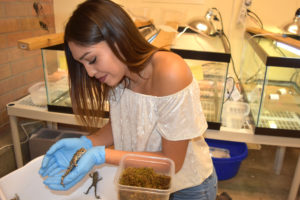
Photo: Margaret McKinney/Highlands University
Highlands biology senior Estrella Gutierrez packs endangered boreal toads for shipment to zoos. She also helped raise the toads from eggs and conducted her own research on the amphibians.
Las Vegas, N.M. – New Mexico Highlands University is donating endangered boreal toads raised from eggs in a biology laboratory at the university to zoos in the U.S. for conservation efforts and education.
Boreal toads are extinct in New Mexico. The Detroit Zoo National Amphibian Center, Denver Zoo, and Staten Island Zoo are accepting the live toads as part of a nationwide effort to preserve the species.
“Boreal toads play an essential role in mountain ecosystems, primarily through providing nourishment to other species,” said Highlands biology professor Sarah Corey-Rivas, who leads the boreal toad research project at the university. “Losing boreal toads weakens the ecosystem, making it harder to recover from disturbances like drought.”
Corey-Rivas, who is a conservation geneticist, said the decline in boreal toads and other amphibian species in North America is due to the chytrid fungal disease.
“We are studying the toad’s immune genes and their ability to fight this fungal disease, which can be deadly,” Corey-Rivas said.
Two years ago, Corey-Rivas led a team of her students on field expeditions to collect boreal toad eggs in the Rocky Mountains of central Colorado and Uinta Mountains of northeastern Utah, collaborating with state wildlife agencies.
Corey-Rivas and her students raised the toads in a laboratory with terrariums. The students also had the opportunity to work alongside their professor to conduct genetic research in her separate Molecular Ecology Laboratory. Eight undergraduates and two graduate students are part of the project.
“Previously, scientists believed habitat quality for boreal toads determined whether they can survive the fungal disease. Our research shows instead that the Utah toads have a genetic arsenal that helps them fight the disease,” Corey-Rivas said.
The research is funded through New Mexico IMBRE, Idea Networks of Biomedical Research Excellence, a National Institutes of Health program.
“This boreal toad research is exciting because it takes science out of the lab and shares it with conservationists. In addition, the boreal toad is a model for understanding disease in amphibians, and more broadly for other vertebrates including humans,” Corey-Rivas said.
Highlands biology senior Estrella Gutierrez is a researcher in Corey-Rivas’ Molecular Ecology Laboratory. The student also helped collect the boreal toad eggs and care for them in the lab while they developed.
“This project gave me the opportunity to truly appreciate both field and lab research and apply my knowledge to a very meaningful conservation effort,” said Gutierrez, a 21-year old native of Las Vegas, New Mexico.
Guiterrez also conducted her own research studies on the boreal toads.
“My research this year focused on mutations in an immune gene in the toads that leads to production of a protein that helps combat fungal disease,” Guiterrez said.
Guiterrez said Corey-Rivas pushes her to be on top of her game in research and internships.
“Dr. Corey is my role model because she is incredibly passionate about research, inspiring me to never give up on my own research dreams,” Gutierrez said.
This summer, Gutierrez landed a paid research internship at the University of Georgia through a program funded by the U.S. Department of Agriculture.
“I’ll be studying soy plant genomics, the collection of genes in the organism,” Gutierrez said.
She said her long-term goal is to pursue a combined M.D. – Ph.D. program in immunology.
